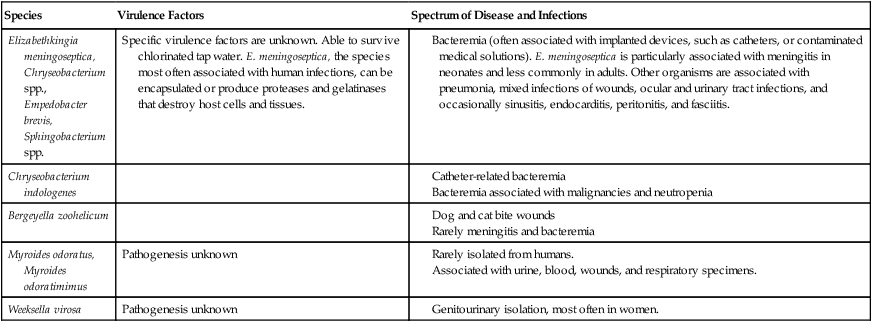1. Describe the general characteristics of the organisms discussed in this chapter. 2. Identify the normal habitat and the routes of transmission for the organisms. 3. List the appropriate media for cultivation of the organisms listed, particularly E. meningoseptica. 4. Describe the colonial appearance of E. meningoseptica. 5. Outline the tests used to differentiate the major genera in this group, including Elizabethkingia sp., Myoides spp., Sphingobacterium spp., and Bergeyella zoohelicum. The organisms discussed in this chapter are environmental inhabitants that are occasionally encountered in human specimens. Most of the organisms originated in the heterogenous group Flavobacterium. However, when subjected to molecular analysis, they did not prove to be closely related and therefore have been reclassified. They are considered together here because they share similar physiologic and morphologic characteristics. Most are yellow-pigmented, oxidase-positive, glucose oxidizers that grow on MacConkey agar. Sphingobacterium spp. have an unusually large amount of sphingophospholipid compounds in their cell membranes. Sphingobacterium mizutaii, which does not grow on MacConkey agar, is discussed in Chapter 27. As environmental inhabitants, these organisms may be found in various niches (Table 24-1). Most notable in terms of clinical relevance is their ability to survive in hospital environments, especially in moist areas. Although they are not considered part of normal human flora, these species can colonize a patient’s respiratory tract during hospitalization. This results from exposure to contaminated water or medical devices. Transmission also may occur directly from contaminated pharmaceutical solutions and, in the case of E. meningoseptica, from person to person. TABLE 24-1 The development of infection basically requires exposure of debilitated patients to a contaminated source, resulting in respiratory colonization (Table 24-2). Depending on the patient’s health, subsequent infections, such as bacteremia and pneumonia, may develop. These infections are most frequently caused by Elizabethkingia meningoseptica or Myroides odoratus. Infections of several other body sites, which may or may not be preceded by respiratory colonization, have been associated with the other species. TABLE 24-2 Pathogenesis and Spectrum of Diseases Bacteremia (often associated with implanted devices, such as catheters, or contaminated medical solutions). E. meningoseptica is particularly associated with meningitis in neonates and less commonly in adults. Other organisms are associated with pneumonia, mixed infections of wounds, ocular and urinary tract infections, and occasionally sinusitis, endocarditis, peritonitis, and fasciitis. Meningitis caused by E. meningoseptica is the most notable infection associated with the organisms listed in Table 24-2. This life-threatening infection, which may be accompanied by bacteremia, originally gained attention because it occurred in neonates. However, E. meningoseptica meningitis can also occur in compromised adults. The organism has been implicated in hospital-based outbreaks of both meningitis and pneumonia. No special considerations are required for specimen collection and transport of the organisms discussed in this chapter. Refer to Table 5-1 for general information on specimen collection and transport. Table 24-3 presents descriptions of the colonial appearance and other distinguishing characteristics of each genus on 5% sheep blood and MacConkey agars. TABLE 24-3 Colonial Appearance and Characteristics
Chryseobacterium, Sphingobacterium, and Similar Organisms
General Characteristics
Epidemiology
Species
Habitat (Reservoir)
Mode of Transmission
Elizabethkingia meningoseptica, Chryseobacterium spp., Empedobacter brevis, Sphingobacterium spp.
Soil, plants, water, food, and hospital water sources, including incubators, sinks, faucets, tap water, hemodialysis systems, saline solutions, and other pharmaceuticals
Not part of human flora
Exposure of patients to contaminated medical devices or solutions, but source is not always known. May colonize upper respiratory tract. E. meningoseptica occasionally may be transmitted from birth canal to neonate.
Chryseobacterium indologenes
Catheter-related infections
Bergeyella zoohelicum
Normal oral flora of dogs and other animals
Dog and cat bites
Pathogenesis and Spectrum of Disease
Species
Virulence Factors
Spectrum of Disease and Infections
Elizabethkingia meningoseptica, Chryseobacterium spp., Empedobacter brevis, Sphingobacterium spp.
Specific virulence factors are unknown. Able to survive chlorinated tap water. E. meningoseptica, the species most often associated with human infections, can be encapsulated or produce proteases and gelatinases that destroy host cells and tissues.
Chryseobacterium indologenes
Bergeyella zoohelicum
Myroides odoratus, Myroides odoratimimus
Pathogenesis unknown
Weeksella virosa
Pathogenesis unknown

Laboratory Diagnosis
Specimen Collection and Transport
Cultivation
Media of Choice
Colonial Appearance
Organism
Medium
Appearance
Rhizobium radiobacter
![]()
Stay updated, free articles. Join our Telegram channel

Full access? Get Clinical Tree

 Get Clinical Tree app for offline access
Get Clinical Tree app for offline access
